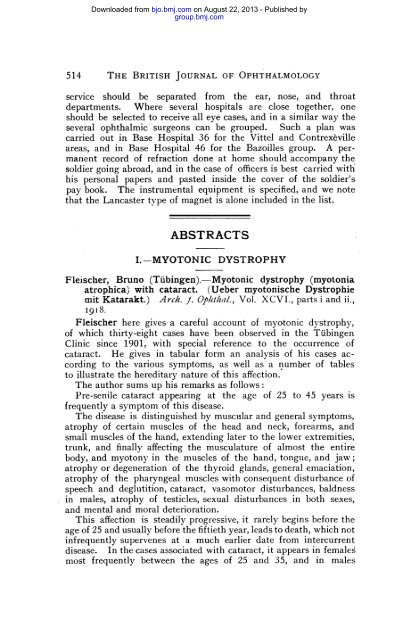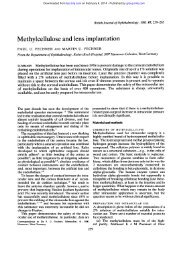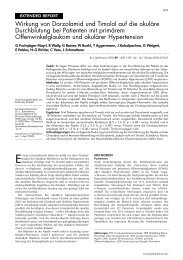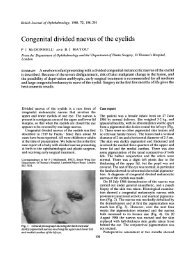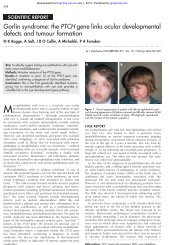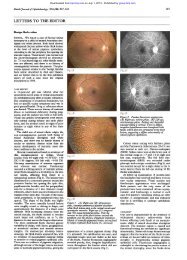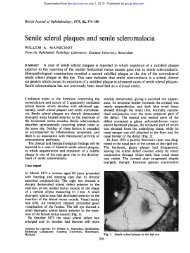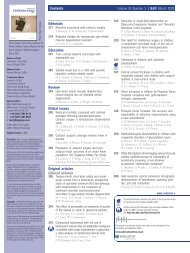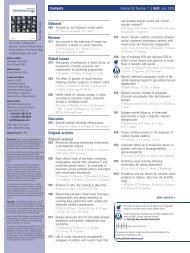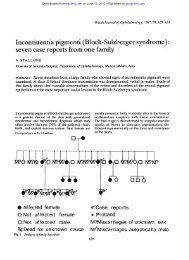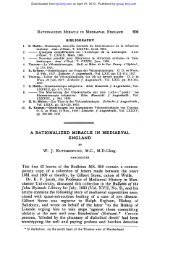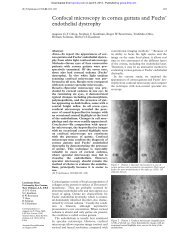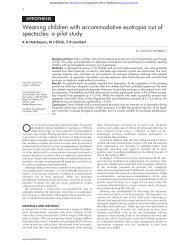ABSTRACTS - British Journal of Ophthalmology
ABSTRACTS - British Journal of Ophthalmology
ABSTRACTS - British Journal of Ophthalmology
Create successful ePaper yourself
Turn your PDF publications into a flip-book with our unique Google optimized e-Paper software.
Downloaded from bjo.bmj.com on August 22, 2013 - Published by<br />
group.bmj.com<br />
514<br />
THE BRITISH JOURNAL OF OPHTHALMOLOGY<br />
service should be separated from the ear, nose, and throat<br />
departments. Where several hospitals are close together, one<br />
should be selected to receive all eye cases, and in a similar way the<br />
several ophthalmic surgeons can be grouped. Such a plan was<br />
carried out in Base Hospital 36 for the Vittel and Contrexeville<br />
areas, and in Base Hospital 46 for the Bazoilles group. A permanent<br />
record <strong>of</strong> refraction done at home should accompany the<br />
soldier going abroad, and in the case <strong>of</strong> <strong>of</strong>ficers is best carried with<br />
his personal papers and pasted inside the cover <strong>of</strong> the soldier's<br />
pay book. The instrumental equipment is specified, and we note<br />
that the Lancaster type <strong>of</strong> magnet is alone included in the list.<br />
<strong>ABSTRACTS</strong><br />
I.-MYOTONIC DYSTROPHY<br />
Fleischer, Bruno (Tubingen).-Myotonic dystrophy (myotonia<br />
atrophica) with cataract. (Ueber myotonische Dystrophie<br />
mit Katarakt.) Arch. J. Op/a/hAl., Vol. XCVI., pa-ts i and ii.,<br />
I 9 1 8.<br />
Fleischer here gives a careful account <strong>of</strong> myotonic dystrophy,<br />
<strong>of</strong> which thirty-eight cases have been observed in the Ttibingen<br />
Clinic since 1901, with special reference to the occurrence <strong>of</strong><br />
cataract. He gives in tabular form an analysis <strong>of</strong> his cases according<br />
to the various symptoms, as well as a number <strong>of</strong> tables<br />
to illustrate the hereditary nature <strong>of</strong> this affection.<br />
The author sums up his remarks as follows:<br />
Pre-senile cataract appearing at the age <strong>of</strong> 25 to 45 years is<br />
frequently a symptom <strong>of</strong> this disease.<br />
The disease is distinguished by muscular and general symptoms,<br />
atrophy <strong>of</strong> certain muscles <strong>of</strong> the head and neck, forearms, and<br />
small muscles <strong>of</strong> the hand, extending later to the lower extremities,<br />
trunk, and finally affecting the musculature <strong>of</strong> almost the entire<br />
body, and myotony in the muscles <strong>of</strong> the hand, tongue, and jaw;<br />
atrophy or degeneration <strong>of</strong> the thyroid glands, general emaciation,<br />
atrophy <strong>of</strong> the pharyngeal muscles with consequent disturbance <strong>of</strong><br />
speech and deglutition, cataract, vasomotor disturbances, baldness<br />
in males, atrophy <strong>of</strong> testicles, sexual disturbances in both sexes,<br />
and mental and moral deterioration.<br />
This affection is steadily progressive, it rarely begins before the<br />
age <strong>of</strong> 25 and usually before the fiftieth year, leads to death, which not<br />
infrequently supervenes at a much earlier date from intercurrent<br />
disease. In the cases associated with cataract, it appears in females<br />
most frequently between the ages <strong>of</strong> 25 and 35, and in males
Downloaded from bjo.bmj.com on August 22, 2013 - Published by<br />
group.bmj.com<br />
MYOTONIC DYSTROPHY<br />
between 35 and 45. The incipient signs <strong>of</strong> cataract are observed<br />
in the earliest stages <strong>of</strong> the disease.<br />
The examination <strong>of</strong> families has shown that myotonic dystrophy<br />
is a markedly familial hereditary aflection, the germ <strong>of</strong> which can<br />
be traced back for five or six generations. The heredity is homochronous<br />
and homologous. This disease, therefore, belongs to<br />
the group <strong>of</strong> typical familial-hereditary diseases <strong>of</strong> a degenerative<br />
character.<br />
Other signs <strong>of</strong> the disease. in descending series <strong>of</strong> generations<br />
are to be found particularly in the appearance <strong>of</strong> pre-senile cataract,<br />
in the generation preceding the myotonia, without other symptoms<br />
<strong>of</strong> myotonic dystrophy-usually at a more advanced age than in the<br />
phase <strong>of</strong> myotonic degeneration-or sometimnes <strong>of</strong> a simple senile<br />
cataract in still earlier generations. To these may be added an<br />
increased infant mortality, childless marriages, celibacy, so that certain<br />
branches <strong>of</strong> the families die out and hence the disease disappears.<br />
The cataract cannot be regarded as the sign <strong>of</strong> a latent tetany<br />
owing to the difference in its form from that <strong>of</strong> tetany; but, like the<br />
latter, it very probably owes its origin lto an aftection <strong>of</strong> the glands<br />
<strong>of</strong> internal secretions.<br />
(In myotonic dystrophy the cataract begins in the posterior cortex with opacity <strong>of</strong><br />
the posterior pole and radiating striae in the form <strong>of</strong> a star; similar changes then<br />
appear in the anterior cortical layers, accompanied by very fine punctate opacities<br />
throughout the lens substance This condition then develops fairly rapidly into a<br />
complete s<strong>of</strong>t cataract with a small nucleus, corresponding to the age <strong>of</strong> the patients.<br />
In tetany the lens frequently shows a large hard nucleus and the cataract commences<br />
with opacities in a supranuclear zone similar to those found in lamellar<br />
cataract.)<br />
With the probability <strong>of</strong> this origin the appearance <strong>of</strong> cataract,<br />
pre-senile and senile, in earlier generations acquires special significance<br />
for the pathogenesis <strong>of</strong> the disease which, owing to the<br />
presence <strong>of</strong> disturbances <strong>of</strong> internal secretion in conjunction with<br />
dystrophic and myotonic symptoms, is <strong>of</strong> great theoretical interest,<br />
especially when the probability <strong>of</strong> changes in the central nervous<br />
system is taken into consideration. The question <strong>of</strong> the connection<br />
between the disturbances in the glands <strong>of</strong> internal secretion and<br />
the aflection <strong>of</strong> the muscles and probable disease in the central<br />
nervous system must be reserved for further research when the<br />
pathological anatomy <strong>of</strong> this disease has been made clear.<br />
By reason <strong>of</strong> its relation to changes in the glands <strong>of</strong> internal<br />
secretion the cataract <strong>of</strong> myotonic dystrophy is <strong>of</strong> very great<br />
interest for the problem <strong>of</strong> the aetiology <strong>of</strong> cataract in general.<br />
The author appends a long list <strong>of</strong> references to the literature <strong>of</strong><br />
the subject, and shows in several plates photographs illustrative <strong>of</strong><br />
the myotonic facies and other features <strong>of</strong> the disease.<br />
THOMAS SNOWBALL.<br />
515
Downloaded from bjo.bmj.com on August 22, 2013 - Published by<br />
group.bmj.com<br />
516 THE BRITISH JOURNAL OF OPHTHALMOLOGY<br />
II.-MACULAR VISION IN HEMIANOPIA<br />
(i) Van Schevensteen, A.- Traumatic incomplete left homonymous<br />
hemianopsia or quadrant anopsia with conservation<br />
<strong>of</strong> the macular visual fields, and- pure word blindness.<br />
(Hdmianopsie homonyme gauche traumatique incomplete<br />
ou anopsie en quadrant avec conservation des champs<br />
visuels maculaires et c6citd verbale pure.) Ann. d'Oculist.,<br />
June, I9I6.<br />
(1) A. Van Schevensteen, junior, records the case <strong>of</strong> a lefthanded<br />
soldier in whom a fracture <strong>of</strong> the right parieto-occipital<br />
region <strong>of</strong> the skull by a shrapnel bullet was followed by homonymous<br />
hemianopic defects in the left lower quadrants <strong>of</strong> his fields <strong>of</strong> vision.<br />
The macular fields were not involved, and the colour fields within<br />
the areas in which vision was retained were normal. The- injury<br />
caused unconsciousness, and on coming to himself, the patient was<br />
blind. He gradually recovered his sight, but his visual acuity never<br />
got better than O@3 in each eye. The defects in the visual fields<br />
remained unaltered for three months. The patient could recognise<br />
printed or written letters easily, and could read usual words <strong>of</strong> one<br />
or two syllables, but could not understand polysyllabic words or put<br />
a sentence together. The internal visual image <strong>of</strong> words was<br />
retained. In writing he had great difficulty in keeping on the lines.<br />
He copied printed letters one by one, and at the end <strong>of</strong> a couple <strong>of</strong><br />
hours he could only read some one- or two-syllable words in his<br />
copy. As is well known, the cortical centre for the mental representation<br />
<strong>of</strong> ideas in right-handed subjects is situated in the left<br />
hemisphiere,. and word-blindness therefore normally accompanies<br />
injuries <strong>of</strong> the left side <strong>of</strong> the head, and is associated with right<br />
hemianopsias; but in the present case the patient being left-handed<br />
word blindness was caused by a lesion <strong>of</strong> the right side <strong>of</strong> the head,<br />
and was associated with left hemianopsia. The case contrasts with<br />
one previously reported by the author' in which an injury to the<br />
right parieto-occipital region. <strong>of</strong> a right-handed man caused<br />
hemianopic defects in the left lower quadrants without great<br />
difficulty in reading. R. J. COULTER.<br />
(2) Vinsonneau, Angers.-Central vision in hemianopics with<br />
intact macular zone. (La vision maculaire chez les<br />
hdmianopsiques A zone maculaire intacte.) Arch. d'Ophtal.,<br />
September-October, I916.<br />
(2) Cases <strong>of</strong> hemianopia due to wounds <strong>of</strong> the skull by firearms<br />
have attracted the close attention <strong>of</strong> ophthalmologists during the<br />
'Arch. d'OPhtal., 1907, p. 158.
Downloaded from bjo.bmj.com on August 22, 2013 - Published by<br />
group.bmj.com<br />
EYE CHANGES IN TRENCH NEPHRITIS<br />
present war. In a paper published in November, 1915 (Arch.<br />
d'Ophtal., Nov.-Dec., 1915, p. 785), Terrien and Vinsonneau<br />
devoted special attention to the condition <strong>of</strong> central vision in cases<br />
<strong>of</strong> hemianopia due to wounds <strong>of</strong> the skull received in battle. An<br />
unexpected result <strong>of</strong> their investigations, to which they directed<br />
attention, was that in a number <strong>of</strong> observations in cases <strong>of</strong> homonymous<br />
hemianopia with preservation <strong>of</strong> macular vision, the visual<br />
acuity <strong>of</strong> the eye on the same side as the loss <strong>of</strong> field (right eye in<br />
right hemianopia, left eye in left hemianopia) was lowered to a<br />
greater degree than that <strong>of</strong> the eye on the opposite side; in other<br />
words, the eye on the same side as the cranial lesion suffered less<br />
deterioration <strong>of</strong> central vision than did the eye on the opposite<br />
side. A study <strong>of</strong> cases published by others seems to confirm these<br />
observations and the authors propose to deal more fully with all<br />
recorded cases bearing on this symptom after the war. They have<br />
already suggested a possible anatomical explanation <strong>of</strong> the unequal<br />
deterioration <strong>of</strong> vision which thev propose to discuss anew in their<br />
later work. J. B. LAWFORD.<br />
(3) Cerise, L.-Two cases <strong>of</strong> double hemianopia with preservation<br />
<strong>of</strong> macular vision. (Deux cas d'hMmianopsie double<br />
avec conservation de la vision maculaire.) Arc/i. d'Op/i/al.<br />
Septemnber-October, I9I6.<br />
In the meantime Cerise reports two additional cases which<br />
exhibit an inequality <strong>of</strong> central vision in favour <strong>of</strong> the eye on the<br />
side <strong>of</strong> the cerebral lesion. (1) Wound by a shell splinter in the<br />
left upper occipital region. Right homonymous hemianopia: right<br />
eye V.= 4/10, left eye V.= 7/10. (2) WVound by a fragment <strong>of</strong> shell<br />
in the left upper occipital region. Right homonymous hemianopia;<br />
with preservation <strong>of</strong> the macular zone: right eye V.=4/1O, left<br />
eye V.=6/10. J. B. LAWFORD.<br />
517<br />
III.-EYE CHANGES IN<br />
TRENCH NEPHRITIS<br />
Kirk, J. (late R.A.M.C.)- Eye changes in trench nephritis<br />
Brit. Med.Jl., January 5, 1918.<br />
Kirk examined the eyes <strong>of</strong> 70 or 80 cases <strong>of</strong> trench nephritis<br />
chiefly in soldiers between 20 and 30 years <strong>of</strong> age, who for the most<br />
part were seriously ill <strong>of</strong> the disease. As a result <strong>of</strong> examination <strong>of</strong><br />
the eyes the cases were classified by the author in three groups,<br />
A, B, and C. Group A numbered about 21 men, all convalescent,<br />
and in 4 only <strong>of</strong> them (19 %/O) were slight retinal changes foundsmall<br />
spots <strong>of</strong> exudation, a punctate haemorrhage, slight haziness
Downloaded from bjo.bmj.com on August 22, 2013 - Published by<br />
group.bmj.com<br />
518 THE BRITISH JOURNAL OF OPHTHALMOLOGY<br />
<strong>of</strong> the optic disc, or a little oedema along the course <strong>of</strong> the veins.<br />
Group B included about 20 patients, with some albumin in the<br />
urine, breathlessness, and oedema, and <strong>of</strong> these cases 8 (40 o/.)<br />
showed minor retinal changes, but 1 suftered from a somewhat<br />
severe neuro-retinitis. Group C, 13 in -number, had nephritis in<br />
marked form, and <strong>of</strong> these 4 had severe and 4 slighter retinal<br />
changes (61 °/o). As regards the retinal changes Kirk notes that<br />
the spots <strong>of</strong> exudation were near the disc and in the macular region,<br />
although the star-like figuret familiar to ophthalmic surgeons was<br />
not observed; haemorrhages were uncommon; the optic disc was<br />
<strong>of</strong>ten affected; small areas <strong>of</strong> oedema were present along the veins;<br />
and, lastly, the gradual absorption <strong>of</strong> the smaller patches <strong>of</strong> exudation<br />
could be followed in several instances. Kirk sums up by saying<br />
that in trench nephritis the retina is very liable to be involved; that<br />
the changes are probably due to a specific toxin; that the retinal<br />
deposit tends- to clear up in most cases; and that the retinal<br />
condition is allied to the acute retinitis <strong>of</strong> pregnancy, scarlatina, and<br />
acute toxaemia, and should not be confounded with the retinitis <strong>of</strong><br />
cheonic nephritis with its permanent changes in the retinal vessels<br />
and tissues. S. S.<br />
IV.-FLAVINE<br />
Lawson, Arnold (London).- Flavine in Ophthalmic Surgery<br />
Lancet, Jutne 28, 19i9. (Op/tl/al. Soc., May, 19I9).<br />
Ophthalmic surgeons everywhere will be much interested in<br />
Lawson's article upon the use <strong>of</strong> flavine in eye work. It is a clinical<br />
and at the same time a critical article in which the author simply<br />
states his experiences <strong>of</strong> the class <strong>of</strong> case in which this drug is <strong>of</strong><br />
service, and <strong>of</strong> the class <strong>of</strong> case in which it is not.<br />
Flavine is employed in one or two forms, namely acriflavine<br />
(methyl chloride <strong>of</strong> diamino-acridine) and pr<strong>of</strong>lavine (hydrochloride or<br />
sulphate <strong>of</strong> diamino-acridine). Both are potent antiseptics, the<br />
bactericidal action <strong>of</strong> which is enhanced by admixture with serum.<br />
They are comparatively nontoxic both locally and generally. In<br />
concentrated solutions pr<strong>of</strong>lavine is the less irritating and this, in a<br />
standard solution <strong>of</strong> 1 in 1000 normal saline, is what the author has<br />
employed. If, however, the solution is to be used for more than<br />
two or three days this strength becomes slightly irritating and<br />
should be reduced to 1 in 4000. The author divides his experiences<br />
into " Wounds " and " Inflammatory Conditions " <strong>of</strong> the eve. In<br />
this coninection it is pointed out and insisted upon that flavine is to<br />
be regarded rather as an antiseptic than as a disinfectant. It is to
Downloaded from bjo.bmj.com on August 22, 2013 - Published by<br />
group.bmj.com<br />
FLAVINE 519<br />
be used to prevent sepsis rather than to cure it. Consequently its<br />
use in wounds is much more valuable than in inflammatory<br />
conditions. There are four classes <strong>of</strong> wounds in which Lawson<br />
has found flavine " <strong>of</strong> the highest value," namely, wounds caused by<br />
foreign bodies, operations requiring sutures, operations on " dirty"<br />
eyes, and as a dressing for grafts.<br />
With regard to the first heading, the author makes the remarkable<br />
statement that in the two years during which he has employed<br />
flavine he has not met with a single case, coming under early<br />
treatment, which has given rise to trouble on the ground <strong>of</strong> sepsis.<br />
Again, in squiint operations, for example, "troubles with sutures<br />
will vanish if flavine is dropped into the eye immediately after the<br />
operation, and its use steadily continued during the wound healing."<br />
With regard to operations on dirty eyes the author's words may<br />
again be quoted. " Perhaps this point most frequently arises in some<br />
cases <strong>of</strong> perforation <strong>of</strong> the cornea with extrusion <strong>of</strong> the iris and in a<br />
certain number <strong>of</strong> cases <strong>of</strong> acute congestive glaucoma. In both <strong>of</strong><br />
these classes the danger <strong>of</strong> sepsis spreading to the wound edges, and<br />
so to the interior <strong>of</strong> the eye, is, I believe, very sensibly diminished<br />
by the use <strong>of</strong> flavine at the time <strong>of</strong> operation, and. for a couple <strong>of</strong><br />
days or so after the operation. In such cases a solution <strong>of</strong> 1 in<br />
1000 can be safely used and is to be preferred to a weaker one."<br />
With regard to grafts Lawson is also quite specific in his<br />
statement :-" The surface to be grafted, after bleeding has been<br />
stopped, should be well swabbed over with flavine (1 in 1000), and<br />
strips <strong>of</strong> gauze well soaked in flavine should be laid over the graft<br />
when applied. This dressing need not be touched for several da7s.<br />
All that is necessary is to moisten the gauze dressing with fresh<br />
flavine from time to time. In the case <strong>of</strong> Thiersch grafts, where it<br />
is most desirable not to interfere with the graft for at least a week,<br />
I prefer to use for the dressing itself the weaker solution <strong>of</strong> flavine<br />
(1 in 4000) rather than the stronger (1 in 1000), and have found it<br />
perfectly efficacious."<br />
With regard to inflammatory conditions <strong>of</strong> the eye, such as<br />
conjunctivitis, flavine alone is not to be relied upon. It is not a<br />
good disinfectant. It may be used in combination with the usual<br />
remedies. Lawson makes the interesting suggestion that flavine<br />
might be found to be a better and safer prophylactic than silver<br />
nitrate against ophthalmia neonatorum. He has not had an<br />
opportunity <strong>of</strong> testing it in this respect, and if one might <strong>of</strong>fer a<br />
friendly criticism, it is that the sentence " I would commend its<br />
trial to midwives and doctors" is in need <strong>of</strong> emendation. The<br />
author considers, from his personal experience, that the use <strong>of</strong><br />
flavine (1 in 4000) is <strong>of</strong> value in actual ophthalmia neonatorum, in<br />
that it protects the cornea from invasion. He employs a drop <strong>of</strong><br />
the weak solution after each irrigation <strong>of</strong> the eye. In corneal
Downloaded from bjo.bmj.com on August 22, 2013 - Published by<br />
group.bmj.com<br />
520 THE BRITISH JOURNAL OF OPHTHALMOLOGY<br />
ulcerations there is, as a rule, no advantage in the use <strong>of</strong> flavine, but<br />
in hypopyon ulcer a solution <strong>of</strong> flavine can be quite safely used to<br />
wash out the anterior chamber. In relapsing blepharitis an ointment<br />
<strong>of</strong> pr<strong>of</strong>lavine oleate (1 in 1000) had a very good effect in one case,<br />
but the author does not feel justified in making positive statements<br />
as to its use in such conditions.<br />
ERNEST THOMSON.<br />
V.-PREVENTIVE LEGISLATION<br />
(i) Allport, Frank (Chicago).-State legislation concerning wood<br />
alcohol. Ophtulalmology, July, I916.<br />
(1) This is the fourth <strong>of</strong> a series <strong>of</strong> papers by Alilport, dealing<br />
with legislation in the United States in its relation to ophthalmology.<br />
It is now well known that wood alcohol, or methyl alcohol, when<br />
either imbibed or inhaled can produce serious toxic symptoms,<br />
leading to blindness and even to death. Wood alcohol is obtainable<br />
on the market in three forms: (1) in its raw, unpurified form,<br />
which is so foul smelling and disgusting to taste that there is little<br />
danger that it will be used for drinking purposes; (2) denatured,<br />
industrial, or domestic alcohol (our " methylated spirit "), mainly<br />
composed <strong>of</strong> ethyl alcohol, but with enough methyl alcohol added to<br />
render it unfit for consumption; and (3) various forms <strong>of</strong> deodorised<br />
or purified wood alcohol, known as Columbian spirits, Colonial<br />
spirits, etc., from which the odour, taste, and colour <strong>of</strong> wood alcohol<br />
have been removed, but without reduction <strong>of</strong> its intensely poisonous<br />
character.<br />
In the United States especially there have been a large number<br />
<strong>of</strong> cases <strong>of</strong> wood alcohol poisoning due to the internal use <strong>of</strong> one or<br />
other <strong>of</strong> these forms <strong>of</strong> deodorised wood spirits. The danger <strong>of</strong><br />
such an occurrence is much increased by the fact that these are<br />
<strong>of</strong>ten sold without warning as to the poisonous nature <strong>of</strong> the<br />
material and under descriptions which disarm suspicion, for<br />
example: "A pure, refined spirit for domestic use," "A perfect<br />
substitute for grain alcohol." The main point in Allport's paper is<br />
that it is unnecessary to run the risks attached to the use <strong>of</strong> this<br />
substance, since denatured alcohol is equally cheap, is easy to<br />
obtain, and does not involve the same dangers.<br />
Within the last ten years eftorts have been made by legislation<br />
throughout the United States to limit the use <strong>of</strong> wood alcohol.<br />
This paper contains a summary <strong>of</strong> the laws <strong>of</strong> the different States<br />
dealing with the subject. Although these laws are, for the most<br />
part, quite clear, and their intention is well known, it would not be<br />
difficult, as Allport points out, to evade them. He goes so far as to
Downloaded from bjo.bmj.com on August 22, 2013 - Published by<br />
group.bmj.com<br />
HEMIANOPIA IN BRAIN INJURIES<br />
suggest that the manufacture <strong>of</strong> " purified "' wood alcohol should<br />
be stopped, or, if it is indispensable for certain industries, it should<br />
pass straight from the manufacturer to the industry concerned, and<br />
should be kept out <strong>of</strong> the hands <strong>of</strong> retail dealers.<br />
f<br />
A. J. BALLuANTYNE.<br />
(2) Allport, Frank (Chicago).-State legislation concerning shop<br />
lighting, shop accidents, shop conditions, the common towel,<br />
etc. Op/thalmology, October, I9I6.<br />
(2) In this article (the fifth <strong>of</strong> the series), Allport points out that<br />
all measures which prevent disease or injury <strong>of</strong> the eyes in industrial<br />
life are not only beneficial to the workers, but also promote economy<br />
by increasing efficiency and output.<br />
Some <strong>of</strong> the measures to which he draws attention are: suitable and<br />
efficient lighting, provision <strong>of</strong> goggles for protection against foreign<br />
bodies or against excessive heat and light, the fitting <strong>of</strong> protecting<br />
hoods and air suction in connection with grinding wheels, and the<br />
employment <strong>of</strong> secure joints in leather belting. He advocates the<br />
abolition <strong>of</strong> the unskilled " shop oculist," and also speaks in favour<br />
<strong>of</strong> the systematic examination <strong>of</strong> the eyes <strong>of</strong> industrial recruits, and<br />
the fitting, where necessary, <strong>of</strong> correcting glasses.<br />
The second part <strong>of</strong> the paper consists <strong>of</strong> a summary <strong>of</strong> the "shop<br />
laws" <strong>of</strong> the different States <strong>of</strong> the Union, which deal directly or<br />
indirectly with the eyes and eyesight. This contains much<br />
interesting and important matter, but cannot be abstracted.<br />
A. J. BALLANTYNE.<br />
VI.-HEMIANOPIA IN BRAIN INJURIES<br />
Best, F. (Dresden).-Hemianopia and sensory blindness in<br />
brain injuries. (Hemianopsie und Seelenblindheit bei<br />
Hirnverletzungen.) Archz.f. Op/tihal., Vol. XC I II, Part i, I 917.<br />
Best has had the opportunity <strong>of</strong> observing numerous cases <strong>of</strong><br />
head injury in the war in which hemianopia was one <strong>of</strong> the<br />
symptoms. In this lengthy paper he publishes notes <strong>of</strong> several <strong>of</strong><br />
his more interesting observations. He points out the difficulty <strong>of</strong><br />
accurate delineation <strong>of</strong> the fields <strong>of</strong> vision in such patients. The<br />
variations in the fields from day to day may be considerable. His<br />
results may be summed up as follows:<br />
Of his hemianopia cases from war injury, 30-2 per cent. were<br />
double, 25'6 per cent. right sided and 44-2 per cent. left sided;<br />
complete blindness as a result <strong>of</strong> double hemianopia was never<br />
observed. Death occurred in 12,8 per cent. One sided hemianopia<br />
with accurate limit through the fixation point occurred once, with<br />
complete destruction <strong>of</strong> the peripheral field, but preservation <strong>of</strong> the<br />
521
Downloaded from bjo.bmj.com on August 22, 2013 - Published by<br />
group.bmj.com<br />
522 THE BRITISH JOURNAL OF OPHTHALMOLOGY<br />
macula in 3-5 per cent. ; retention <strong>of</strong> the peripheral field with complete<br />
loss <strong>of</strong> the macula, never. These figures refer to cases on<br />
discharge. In recent cases <strong>of</strong> hemianopia the proportion <strong>of</strong> cases<br />
in which the inferior field was affected, 58i1 per cent., was much<br />
greater than those in which the superior field suffered, 5i8 per cent.<br />
Paracentral double scotoma without damage to the peripheral field<br />
occurred in 3i5 per cent., double scotoma with damage to the<br />
peripheral field in 12'8 per cent., macular defect with peripheral<br />
destruction in 25-6 per cent., while in 38,4 per cent. there was only<br />
peripheral defect without scotoma or macular defect. In 18,6 per<br />
cent. the pupil on the aflected side was enlarged, in 7 per cent. that<br />
on the opposite side. In 10-5 per cent. nystagmus, in 4.7 per cent.<br />
abducens paresis, in 2-3 per cent. oculomotor paresis, and in one case<br />
total ophthalmoplegia were found. Incorrect optical localization<br />
regularly accompanies hemianopia. In 31V3 per cent. <strong>of</strong> cases<br />
number counting by eye was defective and in 5-8 per cent. there<br />
was optical agnosis. In 25-6 per cent. alexia and in 14 per cent.<br />
agraphia was present.<br />
In cases <strong>of</strong> hemianopia, which practically always occurs in<br />
injuries <strong>of</strong> the calcarine area, all sight functions in the affected<br />
parts <strong>of</strong> the field are damaged ; there is no evidence <strong>of</strong> a special<br />
colour differentiation centre except in so 'far as sensory disturbances<br />
(aphasic) may be affected. The seat <strong>of</strong> the cerebral centre for<br />
optical localization is in the calcarine area, that for the upper<br />
part <strong>of</strong> the field being situated in the lower part <strong>of</strong> the calcarine<br />
fissure and that for the lower part <strong>of</strong> the field in the upper lip <strong>of</strong> the<br />
fissure. As regards the seat <strong>of</strong> the cerebral macula, Best has no<br />
fresh suggestion to <strong>of</strong>fer, but considers that the theory postulating<br />
a seat for both halves <strong>of</strong> the macula in both hemispheres is highly<br />
improbable, since the escape <strong>of</strong> the macula is not a sharply defined<br />
circumference, but a more or less large remnant <strong>of</strong> a hemiamblyopic<br />
field in which the most important part has retained its function.<br />
The rarity <strong>of</strong> the complete destruction <strong>of</strong> half the field <strong>of</strong> vision is<br />
to be explained by the relatively large area <strong>of</strong> the calcarine, the<br />
destruction <strong>of</strong> the lower part <strong>of</strong> which completely is incompatible<br />
with life, owing to the proximity <strong>of</strong> the cerebellum.<br />
The calcarine area is also the centre for reflex ocular movements,<br />
particularly those connected with fusion and convergence. It is<br />
also the centre for optical localization. Alexia and agraphia seem<br />
to follow more <strong>of</strong>ten left sided injury. In general, both these affections<br />
seem to be indepen^dent and not due to narrowing <strong>of</strong> the field<br />
for letters. Primitive visual injuries (such as number counting)<br />
occur equally in lesions <strong>of</strong> either side, but severe sensory blindness<br />
only in injuries-<strong>of</strong> both sides. E. E. H.
Downloaded from bjo.bmj.com on August 22, 2013 - Published by<br />
group.bmj.com<br />
CONTUSION OF GLOBE AFTER SHOT INJURY<br />
523<br />
VII.-CONTUSION OF GLOBE AFTER SHOT INJURY<br />
Igersheimer (Gottingen).-On the anatomy <strong>of</strong> contusion <strong>of</strong><br />
the globe following shot injury. . (Zur Anatomie der<br />
Contusio Bulbi durch Schussverletzung.) Arch. f. Ophkal.,<br />
Vol. XCIII, Pt. ii, 1917.<br />
Igersheimer's case was a soldier <strong>of</strong> 29, who came under observation<br />
six days after his wound. The wound-<strong>of</strong> entry was on the left<br />
side <strong>of</strong> the forehead, near the hair margin, and that <strong>of</strong> exit near the<br />
right outer canthus. The right upper lid was somewhat swollen<br />
and red, the globe slightly proptosed and the pupil did not react.<br />
The vitreous was obscured by blood, but, when this had been<br />
cleared up, a rupture <strong>of</strong> the choroid concentric with the papilla<br />
became visible. It was also possible, a little later, to make out that<br />
the retina was uneven over the white area and that the vessels were<br />
partly obscured by the white mass. A coloured plate <strong>of</strong> the<br />
ophthalmoscopic appearances is given. Two months after the<br />
injury the man was marked for discharge, when meningitis suddenly<br />
set in and he died. Igersheimer obtained the globe and gives a<br />
minute account <strong>of</strong> its microscopical anatomy, illustrated with three<br />
text drawings.<br />
Histological examination showed that the grey-white<br />
mass seen with the ophthalmoscope was a §ubretinal scar tissue<br />
formation <strong>of</strong> the choroid which had projected in a spur-like way<br />
into the retina. In this area the retina was more or less atrophic.<br />
The choroid was split up in its anterior layers through the formation<br />
<strong>of</strong> scar tissue, and the destruction <strong>of</strong> the choriocapillaris and also to<br />
some extent <strong>of</strong> the large vessel layer, while the suprachoroidea was<br />
well preserved. Whether the proliferation <strong>of</strong> the choroidal. tissue<br />
was the primary affection, and the disturbance <strong>of</strong> the pigment<br />
epithelium and posterior layers <strong>of</strong> the retina the second, or whether<br />
the tear in the pigment epithelium produced the other changes, or<br />
finally, the interference with the ciliary circulation was the underlying<br />
cause <strong>of</strong> all the other changes, could not be determined from<br />
the preparations.<br />
Igersheimer adds a brief account <strong>of</strong> another eye in his possession,<br />
in which the final stages <strong>of</strong> such an injury are demonstrable. He<br />
gives no account <strong>of</strong> the nature <strong>of</strong> the injury in this case, but states,<br />
that careful examination revealed no perforation or external injury.<br />
On one side the iris and ciliary body were normal. On this side<br />
the retina was degenerated near the ora serrata; corresponding<br />
with the degeneration, the pigment epithelium had proliferated.<br />
Then followed a broad band in which retina and pigment epithelium.<br />
were well preserved. Further in, the retinal rods and cones were<br />
lost, and the pigment epithelium became iriegular and wandered<br />
into the retina. Close to the papilla there was a scar between
Downloaded from bjo.bmj.com on August 22, 2013 - Published by<br />
group.bmj.com<br />
524 THE BRITISH JOURNAL OF OPHTHALMOLOGY<br />
retina and choroid, as in the previous case. In the other half <strong>of</strong><br />
the globe the retina was completely destroyed, as also the pigment<br />
epithelium and part <strong>of</strong> the choroid, their place being taken from<br />
the papilla to the ora serrata by scar tissue which was half the<br />
thickness <strong>of</strong> the sclera-and contained scattered pigment. The scar<br />
tissue was separated from the sclera by choroidal remnant$ (cross<br />
section <strong>of</strong> vessels and scattered pigment clumps). In the<br />
neighbourhood <strong>of</strong> the ora serrata the vitreous contained blood clot.<br />
The pigment layer <strong>of</strong> -the ciliary body and iris was also affected,<br />
being partly destroyed and partly scattered through the tissue.<br />
E. E. H.<br />
VIII.-MISCELLANEOUS<br />
(Third Notice)<br />
(i) Lo Cascio (Rome).-The composition <strong>of</strong> the pigment <strong>of</strong><br />
melanotic sarcoma <strong>of</strong> the choroid. (Sulla costituzione del<br />
pigmento del sarcomi melanotici della coroide.) Lat Clin.<br />
Oculist, October, 19I5.<br />
(i) The examination <strong>of</strong> the pigment <strong>of</strong> these tumours hitherto<br />
has been faulty, says Lo Cascio, because the method employed to<br />
extract them has involved alteration <strong>of</strong> their composition. He<br />
thinks that he has been able to remove the pigment without<br />
disturbing it by means <strong>of</strong> copious wtashing with distilled water<br />
containing a few drops <strong>of</strong> chlor<strong>of</strong>orm.<br />
He finds the percentage as follows:<br />
C. 53-17 per cent. H. 616 per cent. N. 12'40 per cent. S.<br />
2,53 per cent. Fe. 0152 per cent. P. 0294 per cent.<br />
This agrees closely with the composition <strong>of</strong> the retinal and<br />
choroidal pigments <strong>of</strong> the normal eye, which two have been shown<br />
by Lo Cascio to be identical.<br />
C. 54.45 per cent. H. 5,88 per cent. N. 12-35 per cent.<br />
0. 26'08 per cent. S. 1-77 per cent. P. 0251 per cent. Fe. 0-101<br />
per cent.<br />
The small differences may be due to experimental errors.<br />
HAROLD GRIMSDALE.<br />
(2) Lamb, Robert Scott (Washington).-Cyanosis retinae et<br />
conjunctivae in connection with pulmonary stenosis and<br />
patent ductus arteriosus. Tralns. A nei. Oplath. Soczety,<br />
Vol. XIV, Part ii, I9I6.<br />
(2) Lamb reports cyanosis <strong>of</strong> the conjunctiva and retina in a<br />
coloured girl, aged 13 years, believed to be aflected with pulmonary
Downloaded from bjo.bmj.com on August 22, 2013 - Published by<br />
group.bmj.com<br />
MISCELLANEOUS<br />
stenosis and patent ductus arteriosus <strong>of</strong> congenital origin. The<br />
condition <strong>of</strong> the retinal vessels is shown by two coloured plates.<br />
The vessels, as usual in such cases, were very tortuous and much<br />
dilated; the distinction between arteries and veins could be readily<br />
made.<br />
The palpebral conjunctiva was almost purple, and the bulbar<br />
conjunctiva was congested. The author mnakes some references to<br />
the literature <strong>of</strong> the condition. S. S.<br />
(3) Rochon-Duvigneaud, A. (Paris).-The protection <strong>of</strong> the<br />
cornea in crawling vertebrates (serpents and anguiliform<br />
fishes). [La protection de la corn6e chez les vert6br6s qui<br />
rampent (serpents et poissons anguiformes).] Ann. d'Ocul.,<br />
May, I916.<br />
(3) A. Rochon-Duvigneaud has studied the manner in which<br />
the corneae <strong>of</strong> serpents and anguiliform fish are protected. He finds<br />
that serpents have in front <strong>of</strong> the cornea a kind <strong>of</strong> watch glass<br />
formed by a transformation <strong>of</strong> the lower lid which has become<br />
fixed in front <strong>of</strong> the eye and transparent. There is a modified<br />
conjunctival sac between the cornea and the " watch glass," which<br />
latter is shed with the slough. In anguiliform fish (eels, etc.) a<br />
similar kind <strong>of</strong> protection is developed in a different way. In them<br />
the cornea consists <strong>of</strong> a superficial thick layer continuous with the<br />
skin and a deep thin layer continuous with the sclerotic between<br />
which there is a loose tissue consisting <strong>of</strong> parallel non-anastomosing<br />
fibres which functions as an intra-corneal articulation allowing the<br />
globe to be moved by its muscles under the cutaneous layer <strong>of</strong> the<br />
cornea which forms its protecting layer. There is no conjunctival sac.<br />
R. J. COULTER.<br />
(4) Leenbeer, C. A. (Chicago). - An orbital endothelioma.<br />
Ophthzal. Record, May, I9I6.<br />
(4) Leenbeer has reported on this case <strong>of</strong> orbital endothelioma<br />
on two previous occasions. After removal <strong>of</strong> the tumour by<br />
Kronlein's orbital resection in 1905, the growth recurred. After<br />
1906, and although it apparently never became larger than it was<br />
at the time it was excised, and never gave the patient any trouble,<br />
the eye and orbital contents were exenterated in 1915. The<br />
histological examination showed that the, growth was a perivascular<br />
endothelioma.<br />
The author's conclusions from this case are that: endotheliomata<br />
<strong>of</strong> the orbit are <strong>of</strong> slow growth and painless. They are prone to<br />
return at the site <strong>of</strong> the operation; but the neighbouring lymph<br />
nodes are not affected early.<br />
Apparently, the growth was primarily one affecting the optic<br />
nerve or its sheath, but the writer does not say so.<br />
J. JAMESON EVANS.<br />
525
Downloaded from bjo.bmj.com on August 22, 2013 - Published by<br />
group.bmj.com<br />
526 THE BRITISH JOURNAL OF OPHTHALMOLOGY<br />
(5) Ferree, C. E. and Rand (Bryn Mawr College).-A rnsum=<br />
<strong>of</strong> experiments on the effects <strong>of</strong> different conditions <strong>of</strong><br />
lighting on the eyes. Alin. <strong>of</strong> Op/tLU., Vol. XXV, No. 3,<br />
July, I916.<br />
(5) The object <strong>of</strong> the work by Ferree and Rand was to compare<br />
the effect <strong>of</strong> the diflerent lighting conditions on the eye, and to<br />
find the factors in a lighting situation, which cause the eve to lose<br />
in efficiency and to experience discomfort. The paper mainly<br />
concerns itself with what are spolken <strong>of</strong> as the " distribution factors,"<br />
viz., the evenness <strong>of</strong> illumination, the diftuseness <strong>of</strong> the light, the<br />
angle at which the light falls on the object viewed, and the evenness<br />
<strong>of</strong> surface brightness. The best control <strong>of</strong> these factors is got<br />
when dealing with a room properly lit by daylight; the next best,<br />
when an indirect system <strong>of</strong> artificial lighting is employed. The<br />
direct and semi-indirect systems are also considered. The investigations<br />
were by no means abstract in character. All the variations<br />
obtained were got by employing lighting installations in common<br />
use, and precise specifications <strong>of</strong> illumination efiects were made in<br />
each case. The conclusions arrived at may be very shortly summarised.-(1)<br />
The influence <strong>of</strong> the distribution factors is <strong>of</strong> the<br />
greatest importance. (2) In the direct and setni-indirect systems<br />
too much light is <strong>of</strong>ten used for the comfort and welfare <strong>of</strong> the eye.<br />
(3) The angle at which the light falls on the object is important,<br />
but is not nearly so important as evenness <strong>of</strong> the surface-brightness in<br />
the field <strong>of</strong> vision. (4) Of the systems <strong>of</strong> artificial lighting, that<br />
which runs the indirect method closest is the semi-indirect with<br />
reflectors having a high density. (5) The problem <strong>of</strong> installation is<br />
not so simple for the semi-indirect as for the wholly indirect<br />
reflectors. (6) The most difficult feature in the problem <strong>of</strong><br />
protecting the eye is encountered in the lighting <strong>of</strong> rooms <strong>of</strong> low and<br />
medium height. (7) The loss <strong>of</strong> efficienc) sustained by the eye in<br />
an unfavourable light seems to be muscular, and not retinal.<br />
(8) Eye shades are not an adequate substitute for lamp shades.<br />
(9) The observation <strong>of</strong> motion-pictures causes the eye to lose<br />
heavily in efficiency, and (10) there is a close relationship between<br />
loss <strong>of</strong> visual efficiency and ocular discomfort. R. H. ELLIOT.<br />
(6) Shahan, William E., and Lamb, Harvey D. (St. Louis) -<br />
Histologic effects <strong>of</strong> heat on the eye. Ainerican <strong>Journal</strong> <strong>of</strong><br />
Op/ittlmiiology, August, I916.<br />
(6) Shahan and Lamb have experimented on the rabbit eye with<br />
the view <strong>of</strong> determining the effects <strong>of</strong> heat applied to the cornea.<br />
,This was done by means <strong>of</strong> a "thermophor." The thermophor<br />
is a metal tube containing a thermometer and surrounded by a<br />
resistance coil to generate heat, while within the coil is placed a
Downloaded from bjo.bmj.com on August 22, 2013 - Published by<br />
group.bmj.com<br />
N OTES<br />
zinc-iron sensitive strip to permit the temperature to be kept at any<br />
constant point. Into one end <strong>of</strong> the metal tube are inserted<br />
applicators <strong>of</strong> various shapes to be applied directly to the cornea<br />
(See <strong>Journal</strong> o-f the American Medical Association, August 5, 1916).<br />
In all the experiments, five in number, the applicator had a<br />
diameter <strong>of</strong> 7 mm. and, in all, the time <strong>of</strong> application was ten<br />
minutes, but the degree <strong>of</strong> heat varied from 119 to 136 degrees<br />
Fahrenheit. The anatomical findings in detail must be sought in<br />
the otiginal. The following are the authors' conclusions.<br />
" We might, therefore, conclude from our findings that the<br />
immediate efiects <strong>of</strong> the heated applicator upon a rabbit's eye are<br />
first a swelling <strong>of</strong> the heated portion <strong>of</strong> the cornea due to a localized<br />
oedema, which with increase <strong>of</strong> heat is accompanied by destruction<br />
<strong>of</strong> the anterior epithelium, then a destruction <strong>of</strong> the posterior<br />
endothelial layer, further by a coagulation necrosis <strong>of</strong> Bowman's<br />
membrane and anterior layers <strong>of</strong> the substantia propria <strong>of</strong> -the<br />
cornea, and lastly a swelling and coagulation necrosis <strong>of</strong> the iris.<br />
Later effects are: first, the appearance <strong>of</strong> the infiltration <strong>of</strong> the<br />
anterior layers <strong>of</strong> the cornea with polymorphonuclear leucocytes,<br />
then the formation <strong>of</strong> scar tissue and new blood-vessels to replace<br />
the destroyed substantia propria <strong>of</strong> the cornea. Lastly, the new<br />
connective tissue with its round pigment cells, where before was<br />
iris stroma." ERNEST THOMSON.<br />
527<br />
NOTES<br />
CAPTAIN R. S. KENNEDY, R.A.M.C., was<br />
Deaths. killed upon the field <strong>of</strong> honour in France in<br />
1918.<br />
Azer Wahba, a prominent member <strong>of</strong> the Ophthalmological<br />
Society <strong>of</strong> Egypt, who was in charge <strong>of</strong> Ophthalmic Hospital at<br />
Zagazig, died suddenly in June last, at the age <strong>of</strong> 34 years.<br />
Henry G. S. Warren, assistant ophthalmic surgeon, Royal<br />
Prince Alfred Hospital, died recently at Sydney, Australia.<br />
Mortimer Frank, <strong>of</strong> Chicago, died on April 21, 1919, at the age<br />
<strong>of</strong> 45. He was ophthalmologist to the Michael Reese and to other<br />
hospitals. In matters <strong>of</strong> medical history he was an authority, and<br />
his library <strong>of</strong> rare medical books and engravings was extensive.<br />
Frank van Fleet, <strong>of</strong> New York, died suddenly on April 5, 1919,<br />
at the age <strong>of</strong> 59. He was surgeon to the Manhattan Eye, Ear,<br />
and Throat Hospital.
Downloaded from bjo.bmj.com on August 22, 2013 - Published by<br />
group.bmj.com<br />
<strong>ABSTRACTS</strong><br />
Br J Ophthalmol 1919 3: 514-527<br />
doi: 10.1136/bjo.3.11.514<br />
Updated information and services<br />
can be found at:<br />
http://bjo.bmj.com/content/3/11/514.citation<br />
Email alerting<br />
service<br />
These include:<br />
Receive free email alerts when<br />
new articles cite this article. Sign<br />
up in the box at the top right corner<br />
<strong>of</strong> the online article.<br />
Notes<br />
To request permissions go to:<br />
http://group.bmj.com/group/rights-licensing/permissions<br />
To order reprints go to:<br />
http://journals.bmj.com/cgi/reprintform<br />
To subscribe to BMJ go to:<br />
http://group.bmj.com/subscribe/


